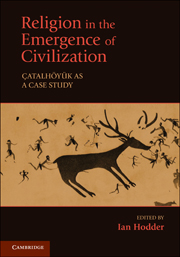Book contents
- Frontmatter
- Contents
- List of Figures and Tables
- Contributors
- 1 Probing religion at Çatalhöyük
- 2 The symbolism of Çatalhöyük in its regional context
- 3 Spiritual entanglement
- 4 Coding the nonvisible
- 5 Modes of religiosity at Çatalhöyük
- 6 Is there religion at Çatalhöyük…or are there just houses?
- 7 History houses
- 8 Marked, absent, habitual
- 9 Temporalities of “religion” at Çatalhöyük
- 10 The Neolithic cosmos of Çatalhöyük
- 11 Magical deposits at Çatalhöyük
- 12 Conclusions and evaluation
- Index
- References
8 - Marked, absent, habitual
Approaches to Neolithic religion at Çatalhöyük
Published online by Cambridge University Press: 05 June 2012
- Frontmatter
- Contents
- List of Figures and Tables
- Contributors
- 1 Probing religion at Çatalhöyük
- 2 The symbolism of Çatalhöyük in its regional context
- 3 Spiritual entanglement
- 4 Coding the nonvisible
- 5 Modes of religiosity at Çatalhöyük
- 6 Is there religion at Çatalhöyük…or are there just houses?
- 7 History houses
- 8 Marked, absent, habitual
- 9 Temporalities of “religion” at Çatalhöyük
- 10 The Neolithic cosmos of Çatalhöyük
- 11 Magical deposits at Çatalhöyük
- 12 Conclusions and evaluation
- Index
- References
Summary
One motive behind the quest for prehistoric religion has been a search for those elements of human existence most characterized by independence from sheer necessity. In this view, religion is an especially strong version of a general cultural capacity to transcend what is merely given. It embodies people's ability to create and to respond to new realities, to project as yet unrealized futures, to exercise their agency in and upon the world. At the same time, religions characteristically displace or deny human agency. Indeed, the displacement and the exercise of agency may be dialectically inseparable from one another. Unknown ancient humans learned to make fire, but if their descendants are to recognize themselves in the deed – to recognize that it is a deed at all – Prometheus must steal fire from the gods. Objectified agency makes possible the reflexivity that transforms habit into inventive, or morally responsible, or simply audacious actions. If one accepts these claims, it follows that religion would seem well suited to play a crucial role in the development of new forms of human agency in the Neolithic.
In this chapter I both develop and challenge these assertions. I begin by criticizing certain assumptions found in theories of Neolithic religion and propose some heuristics for thinking about prehistoric religion. I then turn to Çatalhöyük's artworks, animals and houses, drawing on my own ethnographic materials as a stimulus to reflection. The category of “religion” groups together a wide range of practices, ideas and experiences from diverse sources. I argue that what looks to us like religion may emerge from the convergence of practices that produce effects I call “markedness” and “absence.” These effects stand out from, and take their place amid, the habitual and repetitive activities that surround them. In Çatalhöyük, for instance, the cattle horns that remain after dramatic events of killing and feasting end up marking certain houses whose ongoing reproduction, like that of all houses, is shaped by largely unmarked cycles of birth, nurturance and death. In addition, some houses conceal things (human burials, animal remains inside walls, paintings that have been plastered over) that may point toward potent absences in the midst of those same unmarked activities.
- Type
- Chapter
- Information
- Religion in the Emergence of CivilizationÇatalhöyük as a Case Study, pp. 187 - 219Publisher: Cambridge University PressPrint publication year: 2010
References
- 23
- Cited by



